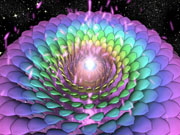

The Vedas are the oldest written tradition in India, (1,500 – 500 B.C.) recorded from oral tradition by upper caste Brahmins, who may have been descended from the Aryan stock which entered India from the north. The original meaning of the word chakra as “wheel” refers to the chariot wheels of the rulers, called cakravartins. (The correct spelling is cakra, though pronounced with a ch as in church.) The word was also a metaphor for the sun, which “traverses the world like the triumphant chariot of a cakravartin and denotes the eternal wheel of time called the kalacakra which represents celestial order and balance.
The birth of a cakravartin was said to herald a new age, and they were described as preceded by a golden disk of light, much like the halo of Christ, only this spinning disk was seen in front of them (perhaps their powerful third chakras). It is also said that the god Vishnu descended to Earth, having in his four arms a cakra, a lotus flower, a club, and a conch shell. (This may have referred to a cakra as a discus-like weapon.)
There is some mention of the chakras as psychic centers of consciousness in the Yoga Upanishads (circa 600B.C.) and later in the Yoga Sutras of Patanjali (circa 200 B.C.). Most interpretations of Patanjali read a dualism between purusha (pure consciousness) and prakriti (the prima materia of the world), implying that the goal of yoga was to rise above nature for the realization of pure consciousness, free of the fluctuations of the mind and emotions. Yet the word yoga means union or yoke, so this realization of consciousness must ultimately reintegrate with nature for a higher synthesis.
The chakra system and Kundalini yoga arose within the Tantric tradition, during the second half of the first millennium, common era. The word Tantra means tool (tra) for stretching (tan) and can be thought of as a loom in which the fabric of nature is woven from the union of opposites. In the West, Tantra is thought of primarily as a sexual tradition, yet sacred sexuality is only a small part of a broad weaving of philosophy which includes many practices of yoga, worship of deities, especially the Hindu goddesses, and integration of the many polaric forces in the universe.
The main text about chakras that has come to us in the West is a translation by the Englishman, Arthur Avalon, in his book,The Serpent Power published in 1919. These texts: the Sat-Cakra-Nirupana, written by an Indian pundit in 1577, and the Padaka-Pancaka, written in the 10th century, contain descriptions of the centers and related practices. There is also another 10th century text, called the Gorakshashatakam, which gives instructions for meditating on the chakras. These texts form the basis of our understanding of chakra theory and Kundalini yoga today.
In these traditions, there are seven basic chakras, and they all exist within the subtle body, overlaying the physical body. Through modern physiology we can see that these seven chakras correspond exactly to the seven main nerve ganglia which emanate from the spinal column. There are minor chakras mentioned in the ancient texts, the soma chakra, located just above the third eye, and the Anandakanda lotus, which contains the Celestial Wishing Tree (Kalpataru) of the Heart Chakra, and other texts mention minor sub-levels to the major chakras.
(This information is to the best of my understanding. If anyone has anything to add to it or finds incorrect information, please Contact Sacred Centers



